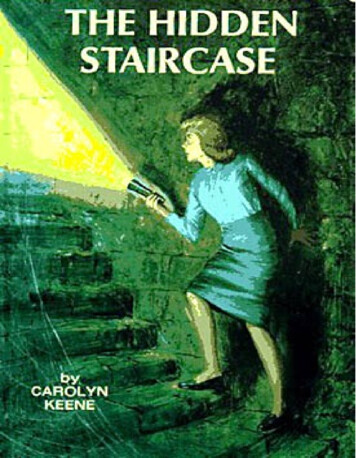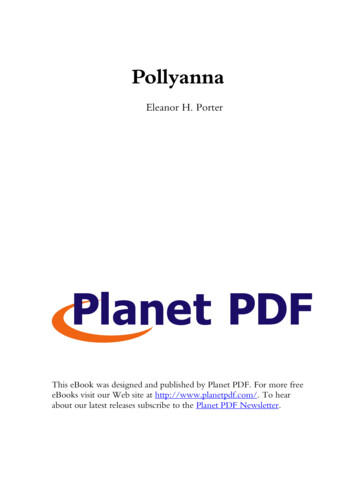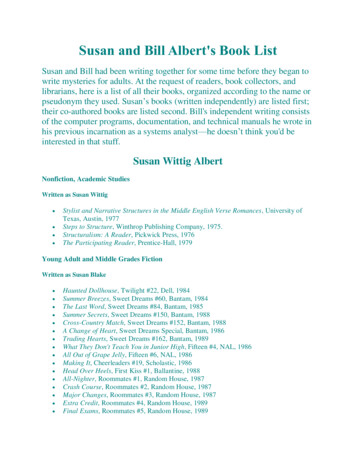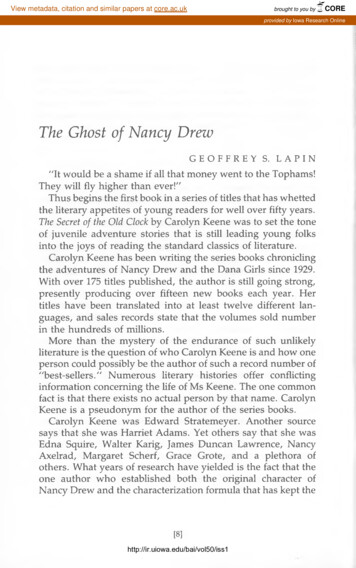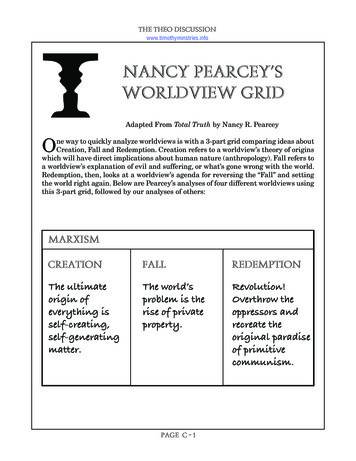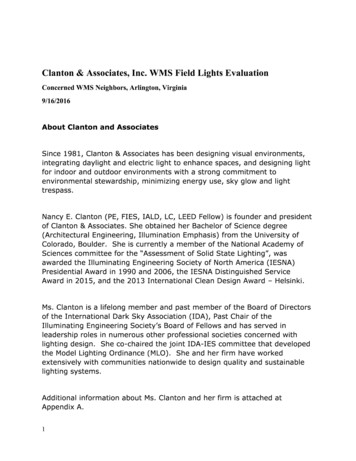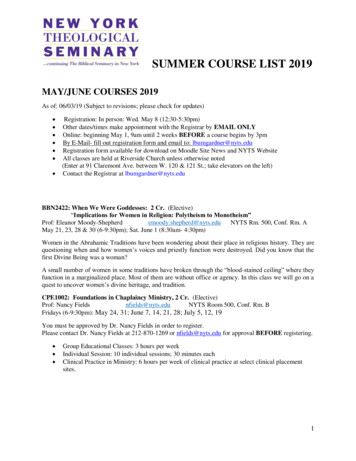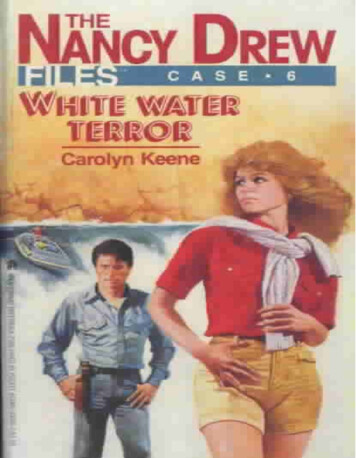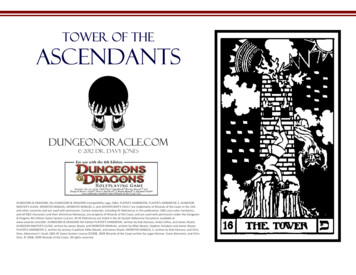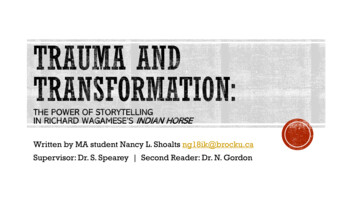
Transcription
Written by MA student Nancy L. Shoalts ng18ik@brocku.caSupervisor: Dr. S. Spearey Second Reader: Dr. N. Gordon
Richard Wagamese’s Indian Horse is a frame narrative that seesthe titular character, Saul Indian Horse, invited by Moses, hisrehabilitation treatment counsellor, to share his story orally inthe circle; when that fails, he suggests that Saul write his story.Saul reluctantly decides to travel that path, recognizing theimportance of story as an opportunity to make sense of hishistory and “get on with life” (Wagamese, Indian Horse 3).Having lost connection to his Indigenous identity, he confides,“Sometimes it feels as though I have spent my entire life on atrek to rediscover it” (Wagamese, Indian Horse 3). So beginsSaul’s return to his childhood, which forms an important part ofuncovering his deeply rooted trauma and beginning hisrecovery. On his mental journey back over his life, he reconnectsand re-roots himself in family, community, and the living world ofnature, all of which are essential to Indigenous cosmology. Indoing so, he begins to heal and continue his path to recovery.
This research project explores how storytelling offersprospects for the storyteller and the listener to reimaginethemselves. As a settler scholar and reader, I am curiousabout the workings of story in the ongoing journey ofhealing from residential school trauma in RichardWagamese’s novel Indian Horse.1)How has storytelling adapted to discuss and addressresidential school trauma?2)How does storytelling work to grant a subject agency?3)How does storywork provide a transformative power tothe storyteller and the listener, thereby allowingopportunity to encounter the trauma and use story toheal?4)How does story function on the private personaldimension of the self and how does it connect to thebroader public collective dimension so that a changedself is also a changed culture and society?
While it is tempting to employ Western scholars andtheory, Kimberley Blaeser (Ojibwe) stresses, “Westerntheoretical models [are] inappropriate for application toAmerican Indian literature/stories” (as qtd. in Archibald16). Following Jo-ann Archibald (Stó:lo), Daniel HeathJustice (Cherokee), and Leanne Betasamosake Simpson(Nishnaabeg), the ethical and respectful, but also themore critical and powerful, approach is to engage solelywith Indigenous scholars who have a long history withstory, who know trauma intimately, and who bestunderstand how to search for answers in their recoverywithin an Indigenous tradition.
Storytelling: Telling a story orally provides opportunity for a storytellerto speak directly to an audience and allows an Elder to assess what their“learner is capable of absorbing” (Archibald 24). In addition, when a storyis told and retold, or read and re-read, the individual learner may takedifferent meanings from the story, depending on their personal need.Colonization and Indigeneity: Contributing to historical ideas ofIndigenous writing and interpretation, Alicia Elliott’s (Tuscarora) workprovides valuable insight into settler colonial practice. Her scholarshipexposes colonial assimilation practices in force by school and churchleaders to maintain authority, to control or erase language, to removechildren from their culture, and to confound Indigenous space byspeaking of past and present but rarely of future.Jo-anneArchibald.IndigenousStorywork.Alicia Elliott.A MindSpread Outon theGround.GraceDillon.Walking theCloudsThomasKing. TheTruth el HeathJustice. ments ofIndigenousStyle.
Trauma: I apply Renee Linklater’s (Anishinaabe) concept of traumato mean “a person’s reaction or response to an injury” (22). SuzanneMethot asserts it is critical that a survivor of abuse create their ownstory about the past traumatic event and their present feelings, therebyallowing them to be an observer to their trauma and divorcingthemselves from the perpetrator’s story.Recovery: It is critical for Indigenous health and healing to “[address]the soul wound” and focus on restoring balance to the individual bycreating relationships with community and with creation (Linklater33). Linklater recognizes the value of resiliency, defined as anelasticity that Indigenous peoples draw on through their connectionand contribution to community relative to healing practices and healthresearch.Daniel HeathJustice. ingSweetgrass.Marie Battiste.ReclaimingIndigenousVoice andVision.SuzanneMethot. Legacy:Trauma, Story,and a Work.
I will mobilize Jo-ann Archibald’s seven principles ofstory—respect, responsibility, reciprocity,reverence, holism, interrelatedness, andsynergy—to study young Saul’s character and thenreconsider each term as he journeys back to family,love, culture, and his familiar landscapes. Inemploying story as part of recovery, Wagamese posesSaul as a worthy, redeemable figure who uses his storyto tell others of his pain and growth. I will take up and incorporate Archibald and Justice’slessons shared about the importance of story to theIndigenous tradition.
I will apply Indigenous theory from Elliott’scolonization discussion to examine students’ time atSt Jerome’s residential school as it reveals marks ofcolonial power and authority, particularly throughthe language that students activate when encounteringwhite authorities, whether imposed by colonialists oroffered as voices of resistance. I will perform a close reading of Indian Horse andfocus on setting, imagery, and the language ofcolonialism and Indigeneity as Saul begins,journeys through, and ends his story.
I will draw upon Methot’s example of the fourquadrants of the medicine wheel and employ themas a roadmap in studying how trauma manifests in atrauma survivor’s narrative. The different quadrantsrepresent vision (spiritual), time (physical), feelingsand reason (emotional), and movement (intellectual). Additionally, I will analyze her ideas of reintegrationto community and her understanding of how“individual narratives are . . . part of the collectivenarrative” in interpreting Saul’s return to wellness(Methot 169).
Linklater’s Indigenous knowledge will be insightful inexamining how Indigenous healing methods, suchas sweat lodges, fasting, and holistic healing cansupport and strengthen the trauma survivor. I willstudy Linklater’s strategies of helping and healingthrough prayer, spiritual connection, love,relationships, cultural and ceremonial resources, andapply them to Saul’s character to show how theycontribute to his reconnection to his home territory,traditions, and Indigenous knowledge. I will dwell on the concept of resilience and how itplaces Saul on his path to wholeness. Only throughtelling story, connecting to wellness, and unearthingpurpose does he find meaning and change. Meaningdoes not come from theory “but through acompassionate web of interdependent relationships”(Simpson 156).
“MY LIFE HAS been changed by the use of a single word—’yes.’ Leaving school atsixteen, having only completed Grade 9, I was untrained and unskilled at anything. Istruggled for years: homeless, in dire poverty, lost. Then one day a possibility waspresented to me—to be a storyteller—and I said ‘yes.’ A journalism career, more thana dozen books and numerous honours later, it’s all because of that yes. There are athousand ways to say “no,” “but,” “I can’t,” “it’s impossible,” “it’s too late,” but there’sonly one way to say “yes.” With your whole being. When you do that, when youchoose that word, it becomes the most spiritual word in the universe And yourworld can change”Richard Wagamese, Meditations 71, 2016.
Indian Horse Text; Wagamese ichard-wagamese/ Literature Review igenous/event/indigenous-scholarsspeaker-series-4/ Methodology (Horse/Eye Indian-Horse-InformationSlideshow-2990417 Research Question Image: n-horse
Archibald, Jo-ann (Q’um Q’um Xiiem). Indigenous Storywork: Educating the Heart, Mind, Body, and Spirit. UBC Press, 2008. Battiste, Marie. “Introduction: Unfolding the Lessons of Colonization.” Reclaiming Indigenous Voice and Vision. UBC Press, 2000. Dillon, Grace. “Introduction.” Walking the Clouds: An Anthology of Indigenous Science Fiction. Edited by Grace L Dillon, Universityof Arizona Press, 2012. Elliott, Alicia. A Mind Spread Out on the Ground. Doubleday, 2019. Hoy, Helen. How Should I Read These?: Native Women Writers in Canada. University of Toronto Press, 2001. Justice, Daniel Heath. Why Indigenous Literatures Matter. WLU Press, 2018. Kimmerer, Robin Wall. Braiding Sweetgrass: Indigenous Wisdom, Scientific Knowledge, and the Teachings of Plants. MilkweedEditions, 2020. King, Thomas. The Truth About Stories: A Native Narrative. Anansi Press, 2003. Linklater, Renee. Decolonizing Trauma Work: Indigenous Stories and Strategies. Fernwood Publishing, 2014. Lowman, Emma Battell, and Adam J. Barker. Settler: Identity and Colonialism in 21st Century Canada. Fernwood Publishing, 2015.
Maracle, Lee. “Indigenous Women and Power,” Memory Serves, edited by Smaro Kamboureli, NeWest Press, 2015. Methot, Suzanne. Legacy: Trauma, Story, and Indigenous Healing. ECW Press, 2019. Murphy, Michelle. “Alterlife and Decolonial Chemical Relations.” Cultural Anthropology, vol. 32, no. 4, 2017, pp. 494–503. Murphy, Michelle. “Some Keywords Toward Decolonial Methods: Studying Settler Colonial Histories and Environmental Violencefrom Tkaronto.” History and Theory, vol. 59, no.3, 2020, pp. 376–384. Simpson, Leanne Betasamosake. As We Have Always Done: Indigenous Freedom through Radical Resistance. University ofMinnesota Press, 2017. Truth and Reconciliation Commission of Canada. Final Report of the Truth and Reconciliation Commission of Canada: Volume One:Summary. Honouring the Truth, Reconciling for the Future. James Lorimer & Company Ltd., Publishers, 2015. Tuck, Eve. “Suspending Damage: A Letter to Communities.” Harvard Educational Review, vol. 79, no.3, 2009, pp. 409–427. Veracini, Lorenzo. The Settler Colonial Present. Palgrave Macmillan, 2015. Wagamese, Richard. Embers: One Ojibway’s Meditations. Douglas and McIntyre, 2016. ---. Indian Horse. Douglas and McIntyre, 2012. Younging, Gregory. Elements of Indigenous Style: A Guide for Writing By and About Indigenous Peoples. U of T Press, 2018.
Braiding Sweetgrass. Gregory Younging. Elements of Indigenous Style. Trauma: I apply Renee Linklater's (Anishinaabe) concept of trauma to mean "a person's reaction or response to an injury" (22). Suzanne Methot asserts it is critical that a survivor of abuse create their own
